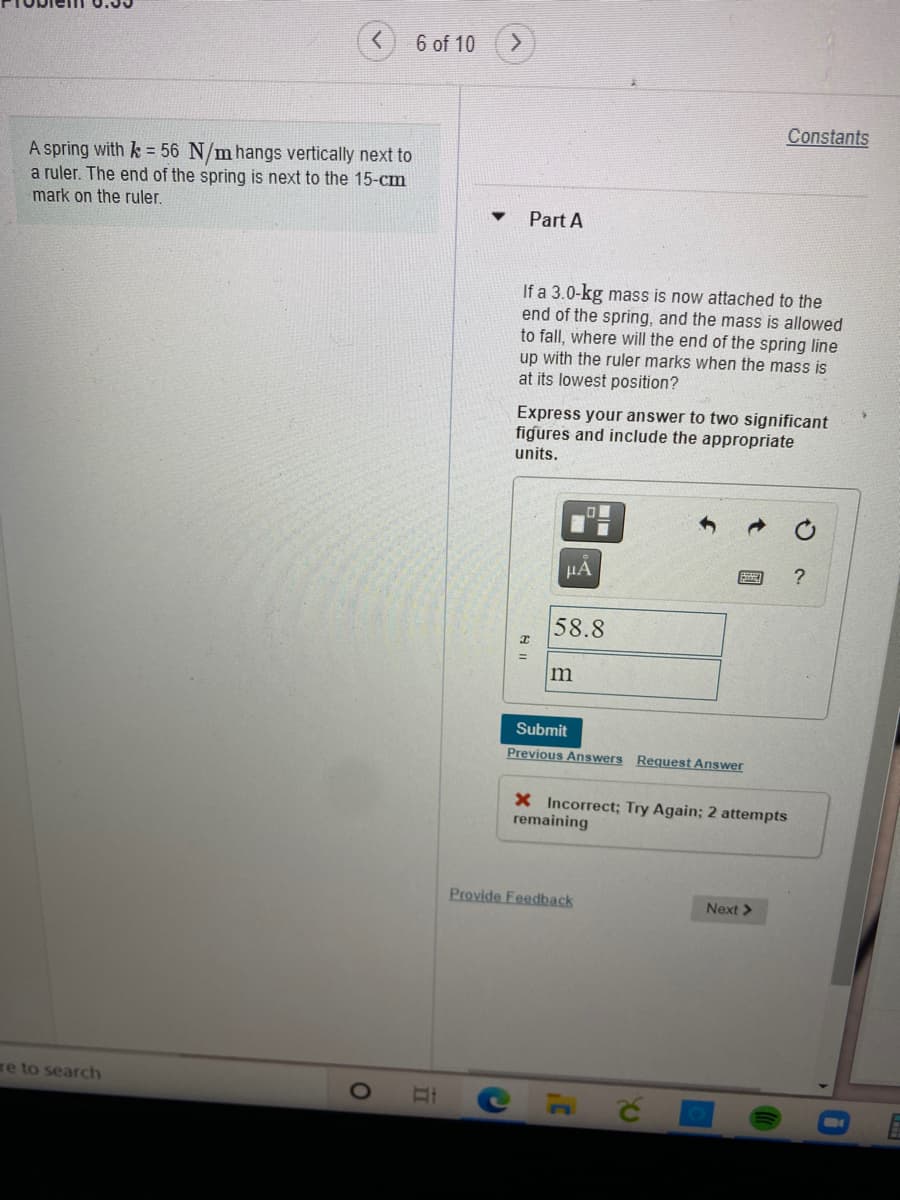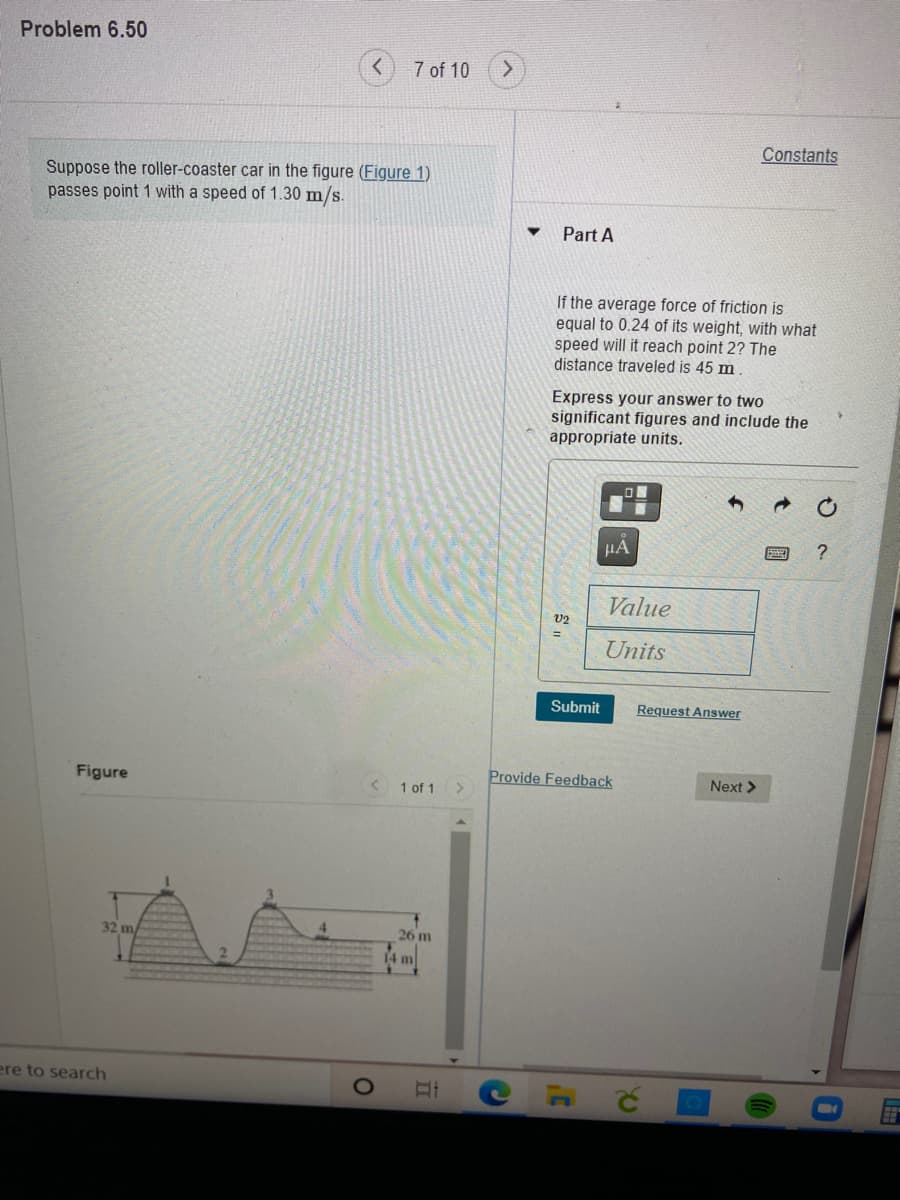Constants A spring with k = 56 N/m hangs vertically next to a ruler. The end of the spring is next to the 15-cm mark on the ruler. Part A If a 3.0-kg mass is now attached to the end of the spring, and the mass is allowed to fall, where will the end of the spring line up with the ruler marks when the mass is at its lowest position? Express your answer to two significant figures and include the appropriate units. HA ? 58.8 %3D m
Constants A spring with k = 56 N/m hangs vertically next to a ruler. The end of the spring is next to the 15-cm mark on the ruler. Part A If a 3.0-kg mass is now attached to the end of the spring, and the mass is allowed to fall, where will the end of the spring line up with the ruler marks when the mass is at its lowest position? Express your answer to two significant figures and include the appropriate units. HA ? 58.8 %3D m
University Physics Volume 1
18th Edition
ISBN:9781938168277
Author:William Moebs, Samuel J. Ling, Jeff Sanny
Publisher:William Moebs, Samuel J. Ling, Jeff Sanny
Chapter6: Applications Of Newton's Laws
Section: Chapter Questions
Problem 118AP: When a body of mass 0.25 kg is attached to a vertical massless spring, it is extended 5.0 cm from...
Related questions
Question
Please answer both questions thank you!

Transcribed Image Text:6 of 10
Constants
A spring with k = 56 N/m hangs vertically next to
a ruler. The end of the spring is next to the 15-cm
mark on the ruler.
Part A
If a 3.0-kg mass is now attached to the
end of the spring, and the mass is allowed
to fall, where will the end of the spring line
up with the ruler marks when the mass is
at its lowest position?
Express your answer to two significant
figures and include the appropriate
units.
HA
58.8
m
Submit
Previous Answers Request Answer
X Incorrect; Try Again; 2 attempts
remaining
Provide Feedback
Next >
re to search

Transcribed Image Text:Problem 6.50
7 of 10
Constants
Suppose the roller-coaster car in the figure (Figure 1)
passes point 1 with a speed of 1.30 m/s.
Part A
If the average force of friction is
equal to 0.24 of its weight, with what
speed will it reach point 2? The
distance traveled is 45 m
Express your answer to two
significant figures and include the
appropriate units.
HA
Value
V2
Units
Submit
Request Answer
Figure
Provide Feedback
Next >
1 of 1
32 m/
26 m
14 m
ere to search
Expert Solution
This question has been solved!
Explore an expertly crafted, step-by-step solution for a thorough understanding of key concepts.
This is a popular solution!
Trending now
This is a popular solution!
Step by step
Solved in 3 steps with 3 images

Knowledge Booster
Learn more about
Need a deep-dive on the concept behind this application? Look no further. Learn more about this topic, physics and related others by exploring similar questions and additional content below.Recommended textbooks for you

University Physics Volume 1
Physics
ISBN:
9781938168277
Author:
William Moebs, Samuel J. Ling, Jeff Sanny
Publisher:
OpenStax - Rice University

Principles of Physics: A Calculus-Based Text
Physics
ISBN:
9781133104261
Author:
Raymond A. Serway, John W. Jewett
Publisher:
Cengage Learning

Physics for Scientists and Engineers: Foundations…
Physics
ISBN:
9781133939146
Author:
Katz, Debora M.
Publisher:
Cengage Learning

University Physics Volume 1
Physics
ISBN:
9781938168277
Author:
William Moebs, Samuel J. Ling, Jeff Sanny
Publisher:
OpenStax - Rice University

Principles of Physics: A Calculus-Based Text
Physics
ISBN:
9781133104261
Author:
Raymond A. Serway, John W. Jewett
Publisher:
Cengage Learning

Physics for Scientists and Engineers: Foundations…
Physics
ISBN:
9781133939146
Author:
Katz, Debora M.
Publisher:
Cengage Learning

College Physics
Physics
ISBN:
9781305952300
Author:
Raymond A. Serway, Chris Vuille
Publisher:
Cengage Learning

College Physics
Physics
ISBN:
9781938168000
Author:
Paul Peter Urone, Roger Hinrichs
Publisher:
OpenStax College